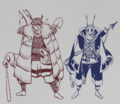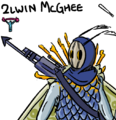Elwin McGhee
Elwin McGhee is a player on the Shadows for the Tokyo Lift, and has been with the team since the Season 10 elections.
Official League Records
McGhee joined the ILB as a lineup player for the Tokyo Lift during the Season 10 elections, after the Ascension of the Baltimore Crabs.
During the Season 14 elections, McGhee's hitting stats were rerolled. 2.7 → 2.6
During the Season 15 elections, McGhee's stats were rerolled and they gained the Alternate and Parasite modifications as a result of the Lift's Alternate Trust will.
On Season 20, Day 39, McGhee was swept ![]() and gained the Negative modification as a result of Nandy Slumps's Undertaker modification.
and gained the Negative modification as a result of Nandy Slumps's Undertaker modification.
On Season 23, Day 39, McGhee retreated to the Lift's Shadows in exchange for Cicero Gubbins at Tokyo Fitness Center via the Ratified Voicemail.
Over the course of Season 24, McGhee entered and exited the Lift's Shadows two times as a result of Tokyo Fitness Center Voicemail events, ending the Season in the Shadows.
The remainder of this article contains lore created collaboratively by the Blaseball community.
Box of Elwin McGhee Files
- Dust billows as the file box lands on the table. While many archives in the Interdimensional Rumor Mill are unified in some way, this... definitely isn’t one of them. The accompanying Rumor Registry explains all of the contents... wherever it is... but for now you grab the folder labelled IF-1667 and start reading...
The waters beyond this point are uncharted, tales from distant shores echoed back into our reality.
Background
The following accounts can be traced to a single leather-bound journal originally found in a locked wooden chest alongside a sextant-like device of indeterminate origin and a shell that matches no known species of mollusc. The chest was located in a storage room in the Legscraper’s lower levels that was described as “smelling faintly of the sea”. Subsequent attempts to locate and navigate to said room have been unsuccessful thus far. The journal details the exploits of the crew of a large sailing vessel, The Tokyo Adrift, descriptions of which are largely consistent with mid-17th century galleons.
With The Tokyo Adrift
Elwin McGhee is the nickname given by the crew of The Tokyo Adrift to a collection of assorted pests found aboard the vessel. McGhee was first discovered after the ship suffered heavy damage over several weeks due to infestations of shipworms and wood-boring beetles. The ship’s quartermaster first discovered heavy damage to the masts and ration storage of the ship, followed by Immateria flooding in the lower decks. Over the weeks, various methods were employed to deal with the pests but to no avail. Captain Strongbody, exasperated, said that he had yet to encounter a problem he could not reason with and headed down to the lower decks calling for a parley. Hours later, Strongbody emerged from the lower decks accompanied by a bipedal insectoid individual who was subsequently named Elwin by the crew.
McGhee and Captain Strongbody came to some form of agreement, the terms of which the journal’s writer was not privy to. However, following the parley, Elwin had been seen to join the crew during meal times where they were provided scrap timber and driftwood. Elwin was also described as helping the crew with the exploration of shipwrecks, utilising their shipworm colonies to bore through the hulls of sunken ships.
Visual descriptions of the exoskeleton are similar to modern day descriptions of ship-timber beetles of the Lymexylidae family, albeit an unusually large specimen. Housed within the external shell were colonies of beetles and shipworms. The writer was unable to get a clear answer from Elwin as to where they obtained the unnaturally large outer husk, though they did report amused chittering echoing from within the shell.
The final pages of the journal mention the discovery of McGhee's empty husk, the hivemind of organisms within having scattered. Whether this change was a natural migration or a side effect of the anomalous weather patterns leading up to the [REDACTED] of 1667 is unclear as the pages are heavily damaged, likely having been chewed through by the larvae of some species of insect.
Gallery
Art by @moliwogs
Elwin McGhee, pre and post-alternation (left and right, respectively). Art by @buzzard
Art of alternate McGhee by @saltbuzzard
| Players | Batters | |
|---|---|---|
| Pitchers | ||
| Shadows | ||
| Buried | James Nolan · Summers Preston | |
| Former |
|
|
| Stats | Season | 1 · 2 · Full List |
| Beta | 11 · 12 · 13 · 14· 15 · 16 · 17 · 18 · 19 · 20 · 21 · 22 · 23 · 24 | |
| Circuits | Gamma 1 · Gamma 2 · Gamma 3 · Gamma 4 | |
| Events | Coffee Cup · Fall Ball | |
| Ballpark | Tokyo Fitness Center | |
| Community Lore | ||
| Staff | Macaquey Caulkin · Kumuscle · 200% Beef Hotdog and Chips (the Third) | |
| History | Tokyo Lift's History · Legscraper · Beef Wings · Beef Wings Corp | |
| Fan Culture 📣 · Fan Works 💌 · Tlopps Cards 🃏 | ||
| Heart and Swole | ||



